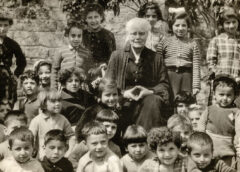Maria Jacobsen, né le à Siim au Danemark et morte le à Byblos, est une missionnaire danoise. Elle est connue pour avoir été une témoin-clé du génocide arménien. Elle est l'auteure de Journaux d'une missionnaire danoise : Harpoot, 1907-1919, ouvrage considéré comme déterminant par l'historien Ara Sarafian. Elle est parvenue à sauver des centaines d'Arméniens (notamment des enfants orphelins) des massacres et des déportations.
Biographie
Hommages
Elle est pour ses actions surnommée Mayrik en Arménie (diminutif affectueux pour maman).
Une large place lui est accordée au musée du génocide de Tsitsernakaberd où une plaque lui rend également hommage. Laura Linney lui prête sa voix dans le documentaire Armenian Genocide
Œuvre
- (en) Maria Jacobsen, Diaries of a Danish Missionary: Harpoot, 1907-1919 , Taderon Pr., 2001 (ISBN 978-1903656075), 266 p.
Notes et références
- (en) Cet article est partiellement ou en totalité issu de l’article de Wikipédia en anglais intitulé « Maria Jacobsen » (voir la liste des auteurs).
Voir aussi
Sur les autres projets Wikimedia :
- Maria Jacobsen, sur Wikimedia Commons
Articles connexes
Liens externes
-
Notice dans un dictionnaire ou une encyclopédie généraliste
 :
:
-
Notices d'autorité
 :
:
Une large place lui est accordée au musée du génocide de Tsitsernakaberd où une plaque lui rend également hommage. Laura Linney lui prête sa voix dans le documentaire Armenian Genocide.
| Année | 1979 |
|---|---|
| Nombre de pages | 422 |
| Editeur | Catholicossat d'Antelias |
| Ville éditeur | Antélias |
She saved these orphans during the Genocide in the American hospital at Kharberd (Harput, modern-day Elazig in Turkey), and later in a Lebanese orphanage following the mass evacuation of children from the Ottoman Empire in the 1920s.
But it is not just as a great and selfless humanitarian that she is remembered, nor as the woman who educated a future archbishop, Husik Santuryan, at the Bird's Nest orphanage for displaced and parentless Armenian children.
The 600-page diary Maria Jacobsen kept between 1907 and 1919, complete with heart-breaking photographs interleaved between the pages, played a huge part in bringing the truth about life and death inside the Ottoman Empire to the wider world.
Born in 1882, Maria learned when young of the Ottoman “Hamidian” massacres of Armenians in the 1890s, and after studying nursing she travelled to Turkey with the Women's Missionary Workers (Kvindelige Missions Arbejdere, KMA). She was the first nurse to reach Kharberd, arriving on her 24th birthday, and already referred to by the doctors there as "the angel of salvation." If her work was made hard by high altitudes and long journeys, it was nothing compared to what came in 1915. The Genocide caused a sea of children to wash up at her door.
She personally adopted three in order to save them, and soon had 3,600 under her protection.

When the United States entered the war and American personnel were forced to leave, Jacobsen took sole charge of the hospital that cared for thousands, and at one point was feeding 4,500 children a day. Her diary entries at the time make for heart-breaking reading. "I thought I should never be able to smile again," she writes, after turning away a boy who was later found dead of hunger. "My heart was shattered," she writes, when a tiny, naked girl is brought to her door with lacerated feet by policemen who otherwise operated as agents of persecution.
Maria smuggled the diary out of Armenia at great danger to her own life when, having contracted typhus from the children she worked with, she was forced to return to Denmark in 1919. Shortly after her convalescence, she was invited to the United States and spent seven months lecturing on the plight of her charges and raising money for them.

Maria soon returned to the Middle East after learning that Near East Relief was extracting 110,000 children from Turkey in the face of further persecution. She went to Lebanon and soon founded what would become the Bird's Nest Orphanage for more than 200 children. She came up with the nickname because the children imploring her for treats reminded her of newly hatched, hungry chicks.
Visitors said the Bird's Nest was more like a school than an orphanage, scrupulously clean and disciplined, the children taking lessons and the girls learning to produce exquisite needlework. Amazingly, Jacobsen kept the home operational during World War II, and in 1950 became the first woman to receive Denmark's Gold medal award for her humanitarian work.
She visited her homeland for the last time in 1957 and died at the Bird's Nest in April 1960. She was buried, according to her wishes, on the grounds.
Images courtesy of the Armenian Genocide Museum-Institute.
The story is verified by the 100 LIVES Research Team.
- Tags:
- More Stories
- Saviors
- Photos
sources : ARAM , wikipedia, musée du génocide arménien "Dzidzernagabert", fondation Aurora
photo : D.R.


